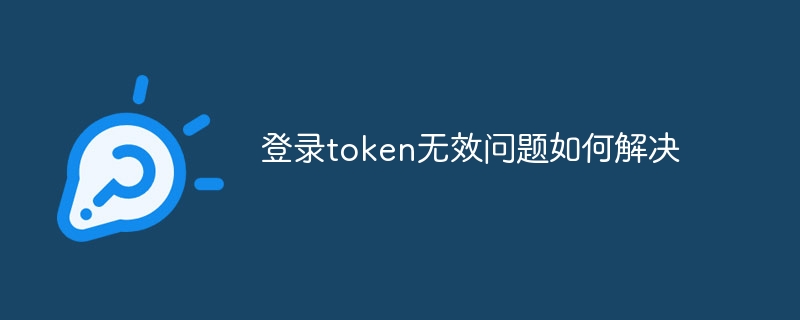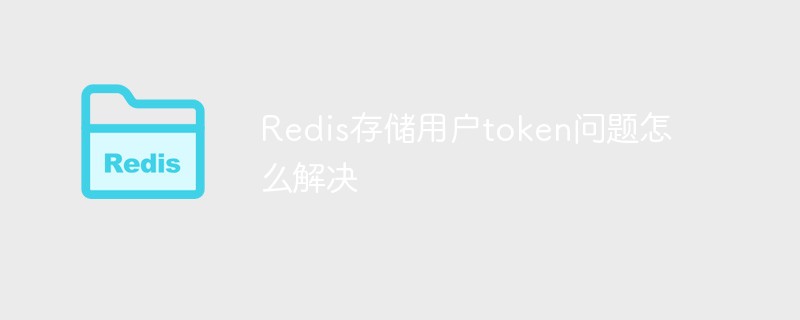Token in vue is a string of strings generated on the server side, used as a token for client requests; its usage methods are as follows: 1. Encapsulate the method of operating local storage local storage; 2. In the encapsulation After the storage is ready, mount it into the global component; 3. Put "token" in "request.js"; 4. Set the routing guard in "index.vue" under the router.

The operating environment of this tutorial: Windows 10 system, vue3 version, DELL G3 computer
What is the usage of token in vue? How to use token in Vue
##1. Understand usage
1. Understand (session, cookie) token Introduction of Token: Token is when the client frequently requests data from the server, and the server frequently goes to the database to query the user name and password and compare them to determine the user name and password. Correct or not, and give corresponding prompts. In this context, Token came into being.
token is a string of characters generated on the server side as a token for client requests. If the front end uses the username/password to request authentication from the server, and the server authentication is successful, the server will return a Token to the front end. The front end can bring Token with each request to prove its legal status. If this Token is persisted on the server side (such as stored in a database), it is a permanent identity token (unless a validity period is set).
2.Token advantages Token is completely managed by the application, so it can avoid the same origin policy
Token can avoid CSRF attacks
Token can be stateless , can be shared among multiple services
Reduce the pressure on the server, reduce frequent database queries, and make the server more robust.
1. When logging in for the first time, the front end adjusts the login interface of the back end and sends the user name and password
The front end gets the token, stores the token in localStorage and vuex, and jumps to the routing page
Judge whether there is a token in localStroage, if not, it will jump to the login page, if there is, it will jump to the corresponding routing page
2. Actual use
1.Method of encapsulating a local cache Create a new storage folder under src, and create a new index.vue
in the folder. The code is as follows:
// 封装操作localstorage本地存储的方法 模块化
var storage = {
set(key, value) {
localStorage.setItem(key, JSON.stringify(value))
},
get(key) {
return localStorage.getItem(key) != 'undefined' ? JSON.parse(localStorage.getItem(key)) : undefined },
getForIndex(index) {
return localStorage.key(index)
},
getKeys() {
let items = this.getAll()
let keys = []
for (let index = 0; index <p>2. After encapsulating the storage, mount it into the global component<code></code> Open main.js under src<br> and add a code: <br></p><pre class="brush:php;toolbar:false">Vue.prototype.$storage = storage;3. Put token in request.js As for what request is, you can refer to another document for details: "How Vue successfully calls a dynamic data interface to solve cross-domain problems":
Click on this document link to jump Method 2 specifically describes request.js
The request.js code is as follows
import axios from 'axios'import storage from '@/storage'import router from '@/router'// create an axios instance
const service = axios.create({
baseURL: '/api', // url = base url + request url
timeout: 5000 // request timeout})// 添加请求拦截器,若token存在则在请求头中加token,不存在也继续请求
service.interceptors.request.use(
config => {
// 每次发送请求之前检测都vuex存有token,那么都要放在请求头发送给服务器,没有则不带token
// Authorization是必须的 let tokenInfo = storage.get('TOKEN')
const token = tokenInfo ? tokenInfo.accessToken : null
const tokenType = token ? tokenInfo.tokenType.substring(0, 1).toUpperCase() + tokenInfo.tokenType.substring(1) + ' ' : null if (token && tokenType) {
config.headers.Authorization = tokenType + token }
return config },
error => {
console.log('在request拦截器检查到错误:', error.response)
return Promise.reject(error)
})// respone拦截器
service.interceptors.response.use(
response => {
return response },
error => {
// 在status不正确的情况下,判别status状态码给出对应响应 if (error.response) {
console.log('在respone拦截器检查到错误:')
switch (error.response.status) {
case 204:
error.response.data.error = '204:No Content(没有内容)'
break
case 401:
// 可能是token过期,清除它
storage.remove('tokenInfo')
location.reload() // 刷新页面,触发路由守卫
error.response.data.error = '401:Unauthorized(未经授权)'
break
case 403:
error.response.data.error = '403:Forbidden(被禁止的)'
break
case 500:
error.response.data.error = '500:服务器内部错误'
break
default: return error }
return Promise.reject(error.response.data.error)
}
return Promise.reject(error)
})export default service4. Set the routing in index.vue under routing and router Guard The entire index code is as follows:
import Vue from 'vue'import Router from 'vue-router'import Login from '@/views/login';import Main from '@/main/index';import tip1 from '@/views/tip1';import tip2 from '@/views/tip2';import tip3 from '@/views/tip3';import storage from '@/storage'Vue.use(Router)const routes = [{
path: '/',
name: 'Login',
// redirect: '/login',
component: Login, }, {
path: "/login",
component: Login, }, {
path: '/Main',
component: Main,
children: [{
path: '/',
name: 'Tip1',
component: tip1 }, {
path: '/tip1',
name: 'Tip1',
component: tip1 }, {
path: '/tip2',
name: 'Tip2',
component: tip2,
meta: {
requireAuth: true
}
}, {
path: '/tip3',
name: 'Tip3',
component: tip3 }, ]
}]const router = new Router({
routes})// 设置路由守卫,在进页面之前,判断有token,才进入页面,否则返回登录页面
router.beforeEach((to, from, next) => {
// 默认requiresAuth为false才不需要登录,其他都要
// to.matched.some(r => r.meta.requireAuth) or to.meta.requiresAuth if (to.matched.some(r => r.meta.requireAuth) !== false) {
let tokenInfo = storage.get('TOKEN')
if (tokenInfo) {
console.log("有token")
next();
} else {
storage.remove('TOKEN')
next({
path: "/login",
query: {
redirect: to.fullPath } // 将刚刚要去的路由path(却无权限)作为参数,方便登录成功后直接跳转到该路由 });
}
} else {
next(); //如果无需token,那么随它去吧 }});//暴露router实例export default router
// 1.将调用登录接口成功以后,把后端传过来的token放入本地缓存
// 2.路由跳转之前执行路由守卫,实例化一个Router对象,使用该对象内置方法beforeEach,在路由跳转前判断该页面是否设置了token,获取token
// 如果有token,next()继续执行路由跳转
// 如果没有token,跳转去登录界面Which page needs routing guard. Just add parameters to him meta: {
requireAuth: true
} recommends learning: "vue video tutorial"
The above is the detailed content of What is the usage of token in vue. For more information, please follow other related articles on the PHP Chinese website!
 登录token无效问题如何解决Sep 14, 2023 am 10:57 AM
登录token无效问题如何解决Sep 14, 2023 am 10:57 AM登录token无效问题可以通过检查网络连接、检查token有效期、清除缓存和Cookie、检查登录状态、联系应用程序开发者和加强账号安全来解决。详细介绍:1、检查网络连接,重新连接网络或者更换网络环境;2、检查token有效期,重新获取一个新的token,或者联系应用程序的开发者;3、清除缓存和Cookie,清除浏览器缓存和Cookie,然后重新登录应用程序;4、检查登录状态。
 登录token无效怎么办Sep 14, 2023 am 11:33 AM
登录token无效怎么办Sep 14, 2023 am 11:33 AM登录token无效的解决办法有检查Token是否过期、检查Token是否正确、检查Token是否被篡改、检查Token是否与用户匹配、清除缓存或Cookie、检查网络连接和服务器状态、重新登录或请求新的Token、联系技术支持或开发人员等。详细介绍:1、检查Token是否过期,登录Token通常会设置有效期,一旦超过有效期,就会被认为无效等等。
 Redis存储用户token问题怎么解决May 31, 2023 am 08:06 AM
Redis存储用户token问题怎么解决May 31, 2023 am 08:06 AMRedis存储用户token在设计类似电商的系统时,一个常见的需求是每个页面都需要携带登录用户信息。常见的解决方法有两种:使用cookie保存使用JWT保存但如果系统中使用了Redis缓存,那么还可以有第三种解决方案–将用户token缓存在Redis中。登陆时生成一个token存入Redis//生成一个token对象,保存在redis中redisTemplate.opsForHash().put("token","user",user)
 Vue3+Vite怎么使用双token实现无感刷新May 10, 2023 pm 01:10 PM
Vue3+Vite怎么使用双token实现无感刷新May 10, 2023 pm 01:10 PM一、token登录鉴权jwt:JSONWebToken。是一种认证协议,一般用来校验请求的身份信息和身份权限。由三部分组成:Header、Hayload、Signatureheader:也就是头部信息,是描述这个token的基本信息,json格式{"alg":"HS256",//表示签名的算法,默认是HMACSHA256(写成HS256)"type":"JWT"//表示Token的类型,JWT令牌统一写为JWT}pa
 聊聊vue指令中的修饰符,常用事件修饰符总结May 09, 2022 am 11:07 AM
聊聊vue指令中的修饰符,常用事件修饰符总结May 09, 2022 am 11:07 AM本篇文章带大家聊聊vue指令中的修饰符,对比一下vue中的指令修饰符和dom事件中的event对象,介绍一下常用的事件修饰符,希望对大家有所帮助!
 如何覆盖组件库样式?React和Vue项目的解决方法浅析May 16, 2022 am 11:15 AM
如何覆盖组件库样式?React和Vue项目的解决方法浅析May 16, 2022 am 11:15 AM如何覆盖组件库样式?下面本篇文章给大家介绍一下React和Vue项目中优雅地覆盖组件库样式的方法,希望对大家有所帮助!


Hot AI Tools

Undresser.AI Undress
AI-powered app for creating realistic nude photos

AI Clothes Remover
Online AI tool for removing clothes from photos.

Undress AI Tool
Undress images for free

Clothoff.io
AI clothes remover

AI Hentai Generator
Generate AI Hentai for free.

Hot Article

Hot Tools

Safe Exam Browser
Safe Exam Browser is a secure browser environment for taking online exams securely. This software turns any computer into a secure workstation. It controls access to any utility and prevents students from using unauthorized resources.

PhpStorm Mac version
The latest (2018.2.1) professional PHP integrated development tool

ZendStudio 13.5.1 Mac
Powerful PHP integrated development environment

SublimeText3 Linux new version
SublimeText3 Linux latest version

Notepad++7.3.1
Easy-to-use and free code editor








